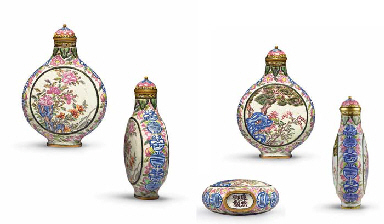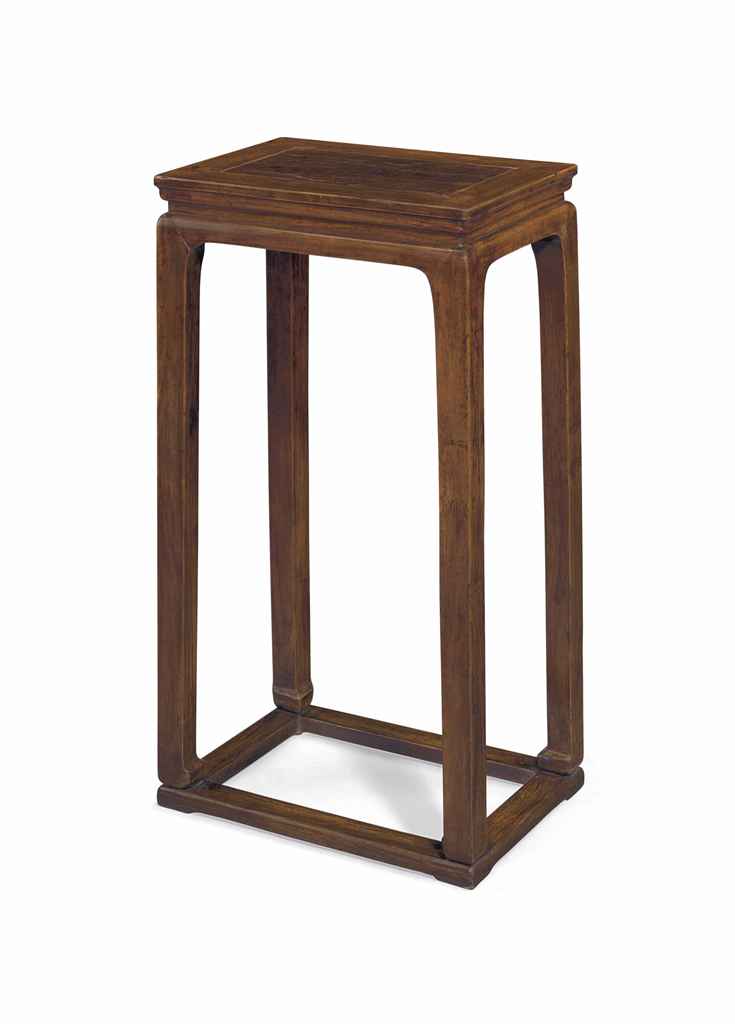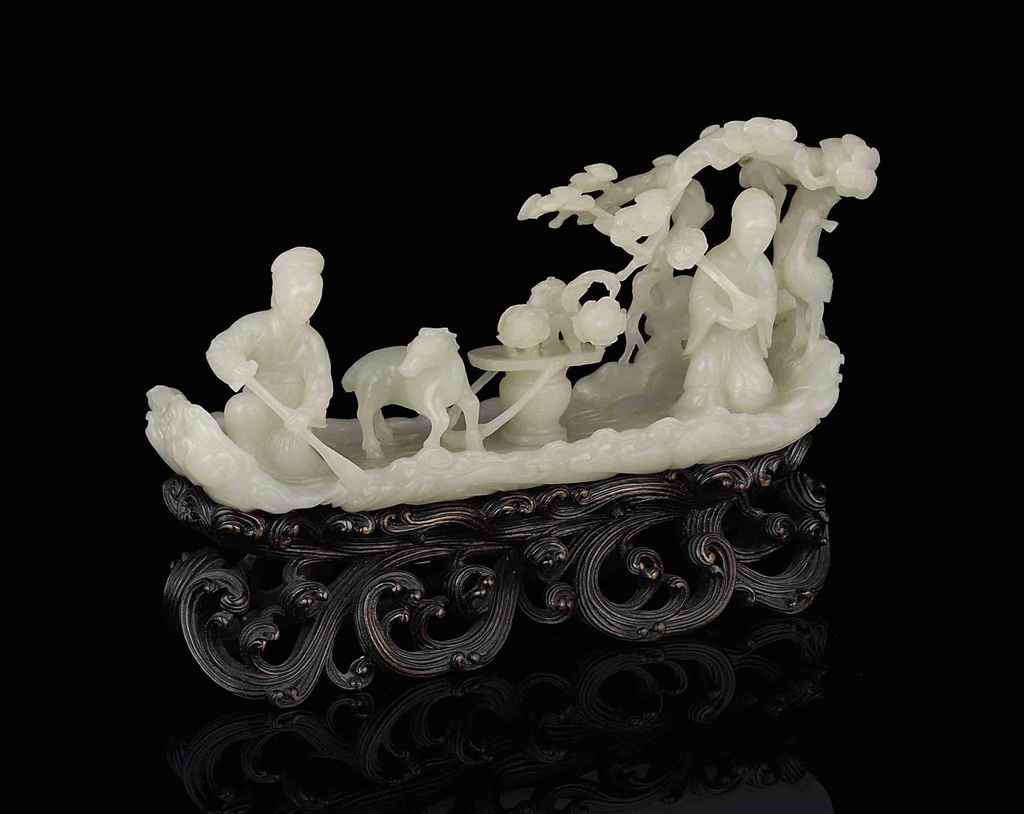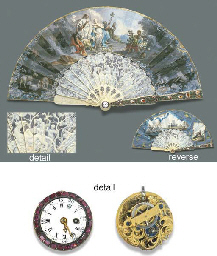A SUPERB AND VERY LARGE CELADON AND RUSSET ‘SEVEN IMMORTALS’ JADE MOUNTAIN, 17th – 18th CENTURY Katalognummer: CA0918-055 Nephrite of intense celadon color with several areas of deep russet cleverly highlighting the carving as well as a few opaque sand-colored veins. Excellent patina and smooth surface polish, as expected on a late Ming / early Qing jade. Exquisitely carved in high relief with several areas of openwork and some reticulated sections. China 17th-18th century Depiction of the seven immortals e. g. the Seven True Daoists of the North, followed by two assistants carrying a pile of books and a scroll, climbing a mountain path towards a pavilion near the summit, all within a craggy landscape of layered rocks and crevices with scattered wutong and pine trees, a waterfall emerging beneath. Two of the scholars are taking a short break from the climb to play a game of weiqi inside a small grotto. The reverse with a pair of deer under a dominant pine tree on a rocky outcrop, sided by several lingzhi fungi and a smaller wutong tree, and two cranes, one standing on a rock and holding lingzhi in his beak, the other flying above the scenery, the massive rockwork rendered in varying layers of relief. Jade is a material that from ancient times has been associated with longevity and immortality. It is therefore a particularly appropriate medium from which to carve representations of the mountainous realm of the Daoist immortals. During the Qianlong reign, the emperor requested that jade mountains, as well as plaques and panels with mountainous landscapes, should take their artistic influence from the work of famous painters. Carvings of mountains can be found in a number of different sizes and depicting varied scenes representing idealized landscapes upon which the collector could contemplate. The virtuosity of the carver is demonstrated here with the remarkable depth and use of the relief carving to depict the layered mountain and three-dimensional scenes, cleverly using the intense russet inclusions to even enhance the latter. On the present boulder the theme of longevity is clearly evident with the depiction of the immortals on the main side and the deer under a pine tree on the reverse. The elongated form of the boulder and the skillful layering of rockwork help to create a magical atmosphere, thereby contributing to the Daoist themes of mysticism and immortality. Shape: Boulder Dimensions: Length 32 cm. Height 21 cm Weight: 7700 grams Condition: Excellent condition. Several natural veins, which over time may have developed into minor hairlines. A few of these show tiny remainders of old wax fill Provenance: Property from an old Swiss private collection. Previously bought at Nagel auctions, Stuttgart Literature comparison: A slightly smaller boulder of similar shape and composition of three sages, is illustrated by Roger Keverne (ed.), Jade, London, 1991, p. 174, fig. 117. Jade boulders of this type range considerably in size, with the largest and most famous in the collection of the Palace Museum, Beijing, measuring over seven feet tall and three feet wide; cf. Zhongguo Yuqi Quanji, vol. 6, no. 255; and nos. 252-256 for the series of boulders in the Palace collection. Cf. a boulder of similar shape and size, included in the exhibition The Refined Taste of the Emperor: Special Exhibition of Archaic and Pictorial Jades of the Ch'ing Court, National Palace Museum, Taipei, 1997, illustrated in the Catalogue, no. 47. An extensive range of large white, celadon and spinach green jade boulders is illustrated in A Romance with Jade from the De An Tang Collection, Hong Kong, 2004, pls. 41-42, 47, 49-51, 55, 60-61, 66, and 69-70. Specifically compare this scene with one depicted on a massive jade mountain in the Palace Museum, Beijing, illustrated in Complete Treasures of the Palace Museum, Jadeware (III), Hong Kong, 1995, no. 77. Auction results comparison: A number of large boulders, sometimes even with imperial i
A SUPERB AND VERY LARGE CELADON AND RUSSET ‘SEVEN IMMORTALS’ JADE MOUNTAIN, 17th – 18th CENTURY Katalognummer: CA0918-055 Nephrite of intense celadon color with several areas of deep russet cleverly highlighting the carving as well as a few opaque sand-colored veins. Excellent patina and smooth surface polish, as expected on a late Ming / early Qing jade. Exquisitely carved in high relief with several areas of openwork and some reticulated sections. China 17th-18th century Depiction of the seven immortals e. g. the Seven True Daoists of the North, followed by two assistants carrying a pile of books and a scroll, climbing a mountain path towards a pavilion near the summit, all within a craggy landscape of layered rocks and crevices with scattered wutong and pine trees, a waterfall emerging beneath. Two of the scholars are taking a short break from the climb to play a game of weiqi inside a small grotto. The reverse with a pair of deer under a dominant pine tree on a rocky outcrop, sided by several lingzhi fungi and a smaller wutong tree, and two cranes, one standing on a rock and holding lingzhi in his beak, the other flying above the scenery, the massive rockwork rendered in varying layers of relief. Jade is a material that from ancient times has been associated with longevity and immortality. It is therefore a particularly appropriate medium from which to carve representations of the mountainous realm of the Daoist immortals. During the Qianlong reign, the emperor requested that jade mountains, as well as plaques and panels with mountainous landscapes, should take their artistic influence from the work of famous painters. Carvings of mountains can be found in a number of different sizes and depicting varied scenes representing idealized landscapes upon which the collector could contemplate. The virtuosity of the carver is demonstrated here with the remarkable depth and use of the relief carving to depict the layered mountain and three-dimensional scenes, cleverly using the intense russet inclusions to even enhance the latter. On the present boulder the theme of longevity is clearly evident with the depiction of the immortals on the main side and the deer under a pine tree on the reverse. The elongated form of the boulder and the skillful layering of rockwork help to create a magical atmosphere, thereby contributing to the Daoist themes of mysticism and immortality. Shape: Boulder Dimensions: Length 32 cm. Height 21 cm Weight: 7700 grams Condition: Excellent condition. Several natural veins, which over time may have developed into minor hairlines. A few of these show tiny remainders of old wax fill Provenance: Property from an old Swiss private collection. Previously bought at Nagel auctions, Stuttgart Literature comparison: A slightly smaller boulder of similar shape and composition of three sages, is illustrated by Roger Keverne (ed.), Jade, London, 1991, p. 174, fig. 117. Jade boulders of this type range considerably in size, with the largest and most famous in the collection of the Palace Museum, Beijing, measuring over seven feet tall and three feet wide; cf. Zhongguo Yuqi Quanji, vol. 6, no. 255; and nos. 252-256 for the series of boulders in the Palace collection. Cf. a boulder of similar shape and size, included in the exhibition The Refined Taste of the Emperor: Special Exhibition of Archaic and Pictorial Jades of the Ch'ing Court, National Palace Museum, Taipei, 1997, illustrated in the Catalogue, no. 47. An extensive range of large white, celadon and spinach green jade boulders is illustrated in A Romance with Jade from the De An Tang Collection, Hong Kong, 2004, pls. 41-42, 47, 49-51, 55, 60-61, 66, and 69-70. Specifically compare this scene with one depicted on a massive jade mountain in the Palace Museum, Beijing, illustrated in Complete Treasures of the Palace Museum, Jadeware (III), Hong Kong, 1995, no. 77. Auction results comparison: A number of large boulders, sometimes even with imperial i



.jpg)




.jpg)




Testen Sie LotSearch und seine Premium-Features 7 Tage - ohne Kosten!
Lassen Sie sich automatisch über neue Objekte in kommenden Auktionen benachrichtigen.
Suchauftrag anlegen